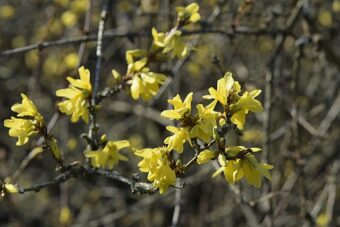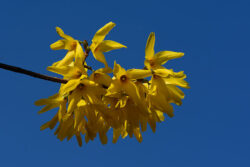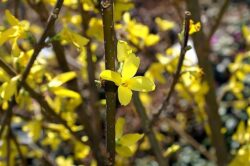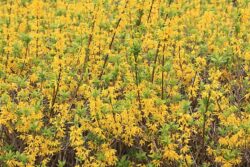In this article, we will be discussing how to grow the herald of spring, the Forsythia, in containers. When you think of forsythia, you think of large shrubs that cannot be possibly grown in containers, but the good news is that they are small species and varieties that will do well in containers.
Forsythia takes its genus name from William Forsyth, a Scottish botanist, who founded the Royal Horticultural Society. It is a relatively small genus of 11 species belonging to the Oleaceae (the Olive) family. It is mainly native to Eastern Asia, but there is one species found growing in South Eastern Europe.

Forsythias are deciduous shrubs that can grow up to 8m tall and have rough, grey-brown bark. The green leaves appear opposite each other and are often simple, but can be trifoliated with a pair of small leaflets at the base. The leaves are normally 2 to 15cm long with a serrated or smooth margin.
The flowers usually appear from March to April well before the leaves appear. Forsythia flowers are often bright yellow (some will say too bright yellow), made up of 4- lobed petals that are joined at the base. The flowers will become pendants when it is raining to protect the reproductive parts. Forsythia flowers are followed by dry capsules containing several wing seeds.
Find out how to grow Forsythia in containers in this article.
GROWING FORSYTHIA IN CONTAINERS
You have a choice as to what kind of Forsythia to grow, either container-grown or bare-root specimens. If you get your Forsythia in containers, it is best to plant in spring or autumn. Bare root Forsythias can be planted in mild periods between November and February.

First, choose a container that is at least 30cm wide in diameter and will suit the plant in question. The containers must have some drainage holes at the bottom to allow the excess water to drain away. On top of this add a thin layer of gravel (1cm) to aid drainage even further. On top of this to within 5cm of the top rim, add multipurpose compost. Nothing special is required.
Dig a hole at the centre of the container slightly bigger than the root ball it came in the original pot you purchased it in or you can plant it straight in if you bought a bare root plant. You can now place the plant in so that the top of the root ball is at the same level as the top of the compost in the container. For the bare root shrub, plant it at the same level it was taken from the ground (often seen as a visible soil mark on the trunk). Backfill with the growing media so that no vacant species remain, using more compost if you need to.
Firm the plant in and water well to allow the compost to settle around the roots.
THE BEST GROWING CONDITIONS
You need to place the containers in a spot where they will get full sun, but they will do well in partial shade, but the flowers will not be as bright.
You must water your Forsythias regularly in the first few years until the plant establishes well. To do this, water when the surface of the compost becomes dry to the touch, this is especially true when heatwaves and hot weather are being forecasted.
Once established you will only need to water when 5cm below the top surface of the compost feels dry to the touch. When you water do so until it emerges from the drainage holes. Look for signs such as shrivelled leaves which is a sign that it may need to be watered.
Forsythias do not need to be regularly fed but to encourage new growth, you may wish to feed it. To do this in spring, sprinkle slow-release, general–purpose fertilizer around the plant and dig it around the roots. You can add a mulch of manure around the plant as a nutrient addition. When you do this create a circle which is mulch-free to prevent the stems from rotting.
PRUNING
This is one shrub for which pruning is required. You cannot simply abandon them, as they will grow tall and ungainly with congested growth on the top and bare stems below. The flowering performance will be better under the shrub as most are borne in long vigorous, shoots if you prune.

Young plants need little in the way of pruning, all you need to do is remove any dead, demanded or crossing shoots in late spring after flowering.
Once a Forsythia has become established, you will need to prune. In mid-spring, immediately after flowering (no later as you will reduce next year’s flower show) cut back flowered growth to vigorous upward or outwards facing shoots close to the shrub. Remove up to one-fifth of the oldest stems from the base of the plant. They will encourage new shoots to form at the base.
In the centre of the shrub, thin out and remove any weak branches. Dwarf cultivars will need little in the way of pruning.
If you have a neglected Forsythia that is too large, or too congested, you can prune it hard. Between autumn and early spring, you can remove and cut back the shrub hard, bearing in mind you will not get any flowers in the first spring after such pruning. You can do it all in one year or you can do it over two years to dull the shock the shrub will feel.
PROPAGATION
Propagation is via layering shoots, softwood cuttings, semi-ripe cuttings, hardwood cuttings or seeds.
For layering, choose a low-growing or flexible stem that can bend down to the ground, then pin it to a 2 litre pot with a loop of wire. After six months the plant will have rooted. Once it has done so, you can cut the connecting stem to the parent plant. You can then allow it to grow on before planting it out.
You can take softwood cuttings from late spring to early summer in a cold frame. Semi-ripe cuttings can be taken from mid-summer to early autumn into small pots and overwintered in a cold frame. You can plant out the following spring.

Hardwood cuttings can be taken from mid-autumn to late winter. This will take the longest to root, as you will need to leave their pots until the following autumn. To root quicker you will need to apply bottom heat.
The slowest way to propagate is via seeds but it may result in a plant different from the parent plant. Once the seed pods are ripe and it has split, you can collect the seeds. Store these seeds until autumn and at this time fill a seed tray full of seed compost. Sow the seeds thinly and just cover them with a thin layer of sieved compost. Leave them outside so that a naturally cold winter will break their dormancy. In spring the seeds should have sprouted.
After that allow them to grow on and when large enough to handle prick the seedlings out and transplant them into 10cm pots full of multipurpose compost. Allow the young plants to grow on and when they are large enough you can plant them in new containers.
PESTS AND DISEASES
Luckily the plants do not suffer from pests and diseases, so is a great plant choice for those who do not want a high-maintenance plant.
VARIETIES TO GROW
For containers, you only have a few choices.
This includes ‘Arnold Dwarf’ that grows up to 1.8m to 2.1m high but is not very free flowering.
‘Mikador’ is a true dwarf that only grows up to 1m high and has a profusion of bright yellow flowers.
‘Minigold’ grows up to 1.2m tall and is a neat, compact shrub.
‘Fiesta’ is a 1m tall shrub that has variegated yellow/green leaves and yellow flowers in late winter to early spring.
‘Nimbus’ grows up to 75cm in height but produces masses of yellow flowers,
CONCLUSIONS
In this article, we have discussed how to grow Forsythia in containers. There are such wonderful plants to have in spring as they are covered with masses of yellow flowers. They are easy to care for, easy to look after, but they do require to be pruned right to get a good display of flowers. Does not suffer from pests and diseases as well, so what is not to like?
If you have any questions or comments that you wish to make on growing Forsythia in containers, please do so in the comment box below.
Happy Forsythia growing.
